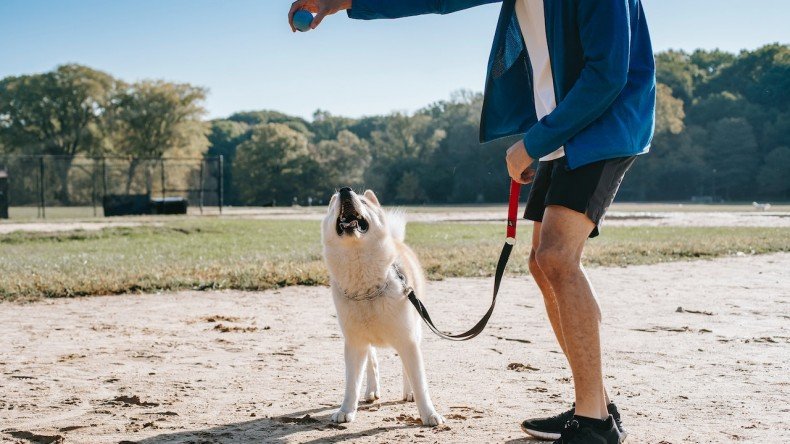By Guest Writer – Michael Lazo
As we enter summer, make sure to pay close attention to your daytime walks with your dog. There’s a reason that we call them the “dog days of summer.”
While the warmth can feel relaxing to humans, the hot Florida sun presents two very serious issues for our canine friends. Many people do not realize how quickly a dog can become overheated or burned in the hot Florida sun, and the severity that these issues pose to canines.
Unlike us, our canine friends do not have the same ability to protect themselves from the heat. It is up to you as a pet parent to ensure that your dog(s) are protected when taking them out for walks and/or exercise.
Overheating and Dehydration
Did you know that dogs only have sweat glands in their ears and the undersides of their paws? That’s why they pant, as a way of releasing heat and exchanging hot air for cool. So, seeing them pant after exercise or on a warm day is normal. But panting excessively is an early sign that your dog is too hot.
Overheating is a serious condition for dogs and can result in death from heatstroke.
Know the symptoms of heatstroke, which include:
-
- Weakness, disorientation, or lethargy
- Heavy and continuous panting or excessive drooling
- Dark red tongue or gums
- Vomiting or seizures
- Glazed eyes
Depending on breed, size, and health conditions, dogs can tolerate heat in different ways.
For dog parents with flat-nosed dogs, such as pugs and bulldogs, be extra vigilant. These breeds have less nasal cavity to help with temperature regulation and are more prone to overheat quickly.

Image credit: International Canine Behaviorists
If your dog is experiencing any or all the above symptoms of heatstroke, the most important immediate action is to get them to a cooler location. Bring them indoors as quickly as possible as heatstroke can be fatal.
Contact your veterinary doctor immediately.
Make sure to follow all the directions provided by your veterinary office. They may ask you to gently spray water on your dog with a hose (outdoors) or in the bath (indoors) to cool down their body temperature. Don’t force your dog to drink any water – let him drink on his own and get him to your vet ASAP.
Tips for Safe Hot Weather Walks
There are some things that you can do to minimize the risk of your dog becoming overheated in the hot Florida sun, these include:
-
- Reserve longer walks for early mornings and evenings.
- Take breaks on walks during warmer times of the day (preferably in the shade).
- Keep mid-day walks shorter and try to stay in shadier areas.
- Avoid over-exertion in hotter weather.
- Always carry water with you on walks, and a collapsible bowl (purchase at any pet retailer).
- Pay close attention to your dog’s behaviors during and after walks, watch for warning signs of heatstroke.
- Make sure your dog has plenty of water available throughout the day and after walks.
- Make sure to educate your children on overheating as well if they are responsible for your dog’s walks.
Pavement Burns
If you have ever had to walk across the hot sand at the beach in the middle of the summer barefoot, you know how quickly your feet can burn. Keep that memory in mind anytime you take your dog out for a walk. Dog’s pads are very sensitive skin that can easily be burned on the pavement.
The picture below shows the extent of injury a dog can experience from hot pavement.

Burn injuries like this can happen very quickly even on a day that is not that hot. If you have ever burned the roof of your mouth on pizza, and then had a hot drink, this is what it feels like for a dog who may have burned his pads.
Believe it or not, even in temperatures below 80 degrees, your dog can burn his paws. The chart below illustrates how hot the pavement can get in normal temperatures:

Tips to Avoid Pavement Burns
There are several preventative measures you can take to minimize the risk of paw burns, including:
-
- Taking walks in cooler parts of the day and avoiding asphalt or pavement and sticking to grass.
- Purchase booties for your dog to wear in hot weather (any pet retailer). Make sure your dog has used them in the house and is comfortable with the use of booties.
- Paw wax – this is another way to keep your dog’s paws safe from burns.
- Make sure to educate your children about hot pavement if they are responsible for walking your dog.
The most important thing you can do is to check the temperature of the pavement with the 5 Second Test.
The 5 Second Test
The 5 second test is very simple. Before walking your dog on the pavement or asphalt, place your palm directly on the surface. Do a slow count to five. If you do not need to pull away your hand due to burning sensation, then it is safe for your dog. If it’s too hot for you, then it’s too hot for them!
Final Thoughts
The onset of warmer weather is a great time to spend outside with our canine friends, giving them the necessary exercise and play that keeps their lives enriched. With a lot of common sense and attention, your dog can be safe in any hot weather situation. Don’t let your dog become a victim of the hot Florida sun – take the right measures to keep him safe and happy!




